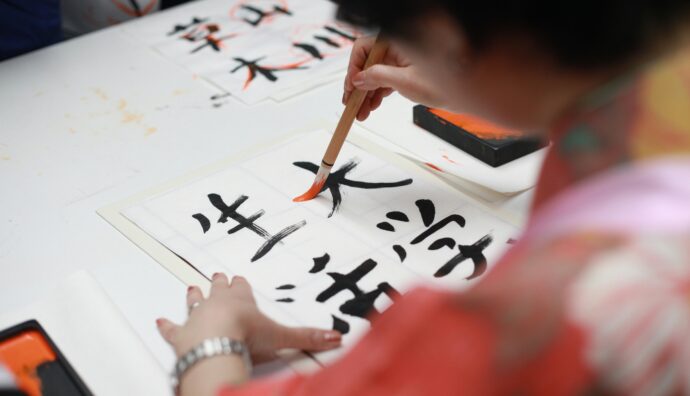It took me several years before I understood and felt that Ueshiba Sensei’s Aikido was very different from that of his disciples. It must also be said that each of his students practiced it in their own way, according to their own personal motivation, according to their own open-mindedness. […]
What was, based on what I was able to notice, the essential difference between Sensei and his students? The students, with the exception perhaps of a few, were fascinated by the extraordinary power of the Sensei, and followed him with the aim of acquiring this power, to become ever stronger. They have arrived, in general, at the Aikido of consolidation whose formula consists in consolidating oneself, through the incessant search for strengthening the weak points. […]
Ueshiba Sensei’s Aikido seemed to me to be something completely different: it was the Aikido of conciliation, of communion with the Universe. I felt in his personality, in his behavior and in his technique, a condition of complete spoliation. He was as unassailable as air, and whoever attacked him was swept away into his vortex. […]
It is infinitely easier to explain consolidation. In any case, it is more logical to indicate and provide the target to be achieved, with the promise of an increase in effectiveness, in terms accessible to all.
Even if one understands and accepts Aikido as the path to communion with the Universe, this will happen on a purely spiritual level. As soon as one is faced with real difficulties, the spirit gives way to raw aggression.
By watching people practice, I ended up feeling what had driven each one to practice. There are as many Aikido as there are practitioners, in the same way that there are as many handwritings as there are writers. What is terrible is that the initial motivation, intimate and subconscious, often remains unchanged, despite practice. Rare are those who admit the narrowness of their views and bring about a radical change in their attitude.
However, this was the case with Ueshiba Sensei. He said he was in his first year of aikido. I felt that his evolution never came to an end.
This is the precious witness of Itsuo Tsuda (1914 -1984) contained in “The science of the particular“, which dates back directly to the years in which Tsuda was a student of Morihei Ueshiba.
There is not much to add but much to reflect and meditate on.
Aikido is a discipline. We can label something as “discipline” if it is alive. And it is alive if it evolves. The proof is that the founder’s Aikido appeared different in every respect from that of the students.
This leads to the need to accept that in the container that we now call Aikido there is a content that is certainly very different from what the founder experienced on a daily basis; equally certainly it is something very distant from what the first students experienced.
What accounts for this difference? Where is it found?
It is not a difference in form: human body’s geometry means that the immobilization and throw techniques are roughly always the same. A work of philology can perpetrate the form both in techniques with bare hands and in those with weapons.
The difference arises, says Tsuda, from the reasons why a person dedicates himself to a discipline. Everyone’s motivations lead each one to the interpretation of the same form and therefore to the definition of as many Aikido as there are those who practice it.
Often the motivation is unclear. It often reveals itself along the way, a bit as if one decided to leave on a journey and then, having arrived at or near the destination, he/she was convinced that that was exactly where he/she wanted to go. Many times the reasons vary over time.
Most of the time, Tsuda suggests, the motivations aren’t all that noble. Often they simply try to become more and more solid, more and more impenetrable. This is Aikido of consolidation.
Aikido, in its origins, however, has its foundations on an opposite attitude: complete spoliation as the only requirement to achieve an Aikido of conciliation.
A bit like when faced with figures like Saint Francis of Assisi, we are all fascinated by his radicality. A saint for many, for others just a visionary rebel; for everyone a person who had the courage of complete spoliation. Eight centuries later, his figure and his testimony are alive and spread throughout the world.
What stops us, what keeps us from becoming another Francis of Assisi, another Morihei Ueshiba?
Most likely, not everyone is required to be the same radical. There would be too many O Senseis around and the world of Aikido is already chaotic as it is. And there would be too many people walking around naked in Assisi without a penny in their pockets (what pockets can you have if you’re naked, after all?).
Assuming this is the case, the primary spoliation is mainly to expose one’s own motivations – or their total absence. One way or another, this is the first step to understand whether you want to take advantage of a discipline to change or not.
And if we change through discipline, discipline changes with us.
If this were the case, the differences in style and teaching lines in a martial discipline would be the evidence of a dynamic, evolutionary trend. It would be a hugely positive sign.
If, however, they were the crystallization of forms kept alive without understanding their reasons, waiting for them to reveal themselves in some way sooner or later, it would be a sign of the deepest stagnation.
One way or another, trying to reconcile form and motivation, style and discipline, yourself and others: this is Aikido and it’s worth trying to see where it takes us.
There where the very first year of Morihei Ueshiba’s Aikido led him.
Disclaimer Picture by Engin Akyurt from Pexels

